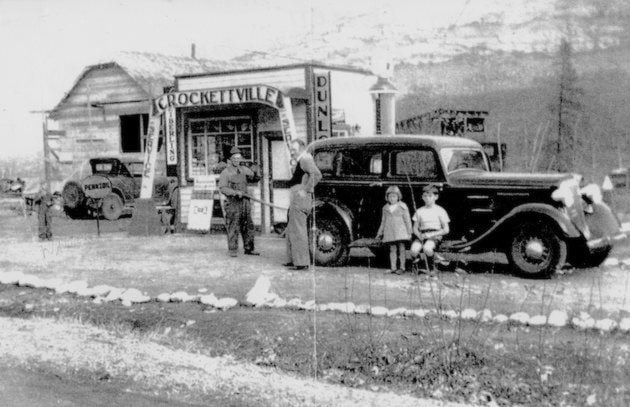One hundred forty-first in an alphabetical series on West Kootenay/Boundary place names
Oasis, just north of Trail, was originally called Crockettville after Harrison (Shorty) Crockett (1903-90) and his wife Kathleen (Kate).
According to Trail of Memories, the couple “rented the Old Doc Perdue orchard, across the highway from what is now known as Rivervale … In 1938, after living at the Perdue place for about four years, Harry built a house and store … They sold gas, oil, confections, and food: bulk sugar, flour, and canned goods. He built a two-bay garage where he repaired and painted vehicles.”
The store was going to be called Morning Glory Service, but instead became Crockettville Service.
In A Trail to Remember, Harry and Kate’s son Walter writes: “How it came to be I don’t know, but the Trail Times staff marked the outside wrapper with ‘Crockettville.’ I was told that when the Castlegar Transportation Society cars were going to work on afternoon and night shift, the men riding the car from Castlegar would remind the driver ‘Don’t forget to pick up the guys at Crockettville.’”
The earliest known mention of Crockettville is in the August 1942 issue of Cominco Magazine: “Harry Crockett, diminutive but energetic ‘Mayor of Crockettville’ and the residents who pitched in and helped, certainly do deserve a big hand for the work they have done in the little community four miles along the Castlegar road from Trail … [T]he entire community boasts a population of only about 35 men, 35 women, and 70 kids.”
The Crocketts sold their business to Len Bond in 1944. When a post office opened on Sept. 16, 1946, it was called Oasis. An early newspaper mention appeared in the Trail Daily Times on Oct. 18 of that year: “A car driven by Leslie Richard Hilts was badly damaged when it overturned on the wrong side of the highway just north of Oasis (Crocketville) at approximately 10:45 last night.”
In the Oct. 24, 1970 edition of Star Weekly, resident Albert Donaldson observed: “I don’t know why they ever chose [the name]. You’d expect to find palm trees or something, but there’s nothing like that around here.”
So where did it come from? Trail of Memories notes Harry Crockett “would thaw water pipes that led from the house to a spring up the mountain side. Nine times out of ten, water had to be packed from a spring along the highway just below the Green family estate.”
The spring 2004 edition of the Trail Journal of Local History says land surveyor John D. Anderson “named his property here Little Oasis. In the mid-1940s this name was adopted by the post office. ‘Little’ was subsequently dropped.”
The post office closed in 1970.
Oatescott
This place, north of Needles on the west side of Lower Arrow Lake, was formerly known as Christie’s Landing and Lascelles Landing.
According to Whistle Stops Along the Columbia Narrows, it was originally named after Alex Christian, or Christie (1873-1924), a prominent Sinixt man whose family lived at what’s now Brilliant. Christie sold his land to William James Lascelles (1858-1921), a brother to the Earl of Harewood and an Indian army veteran.
Christie’s Landing and Lascelles Landing were apparently interchangeable, for the Nelson Daily News of Aug. 28, 1913 noted: “W.J. Lascelles of Lascelles Landing spent a few hours in town last night” but on Oct. 14 of the same year: “Mr. Lassells [sic] of Christie’s Landing is spending a few days in town.”
Sometime before 1918 Lascelles renamed his property Oatescott (also spelled Oatscott) in honour of two members of an ill-fated Antarctic expedition, Capt. L.E.G. (Titus) Oates (1880-1912) and Capt. Robert Falcon Scott (1868-1912). Oates, suffering from frostbite, walked into a blizzard to face certain death so his companions might live, although his sacrifice was unsuccessful. Scott died days later.
Oatescott is first mentioned as a steamer landing in the 1918 Wrigley’s directory for BC.
Capt. Oates is also remembered in Mount Oates, on the BC-Alberta boundary in Hambler Provincial Park.
The Arrow Lakes Indian Reserve, established in 1902, was later known as the Oatscott Reserve. After the last registered band member on the reserve died in 1953, the Canadian government declared the tribe extinct, although over 250 members lived in the US.
Today the only thing left at Oatescott is a grave marker which remembers 15 members of the band buried there (pictured below).
Eileen Delehanty Pearkes photo

Previous installments in this series
Applegrove, Appleby, and Appledale revisited
Bakers, Birds, and Bosun Landing
Bannock City, Basin City, and Bear Lake City
Bealby Point (aka Florence Park) revisited
Boswell, Bosworth, Boulder Mill, and Broadwater
Brooklyn, Brouse, and Burnt Flat
Camborne, Cariboo City, and Carrolls Landing
Carmi, Cedar Point, Circle City, and Clark’s Camp
Carson, Carstens, and Cascade City
Christina City and Christian Valley
Cody and Champion Creek revisited
Champion Creek revisited, again
Columbia City, Columbia Gardens, and Columbia Park
Crawford Bay and Comaplix revisited
Dawson, Deadwood, and Deanshaven
English Cove and English Point
Forslund, Fosthall, and Fairview
Fort Shepherd vs. Fort Sheppard, Part 1
Fort Shepherd vs. Fort Sheppard, Part 2
Gladstone and Gerrard, revisited
Hall Siding and Healy’s Landing
Hudu Valley, Huntingtdon, and Healy’s Landing revisited
Inonoaklin Valley (aka Fire Valley)
Jersey, Johnsons Landing, and Jubilee Point
Kootenay Bay, Kraft, and Krestova
Kuskonook (and Kuskanax), Part 3
Labarthe, Lafferty, and Longbeach
Makinsons Landing and Marblehead
McDonalds Landing, McGuigan, and Meadow Creek
Meadows, Melville, and Miles’ Ferry
Mirror Lake and Molly Gibson Landing
Montgomery and Monte Carlo, Part 1
